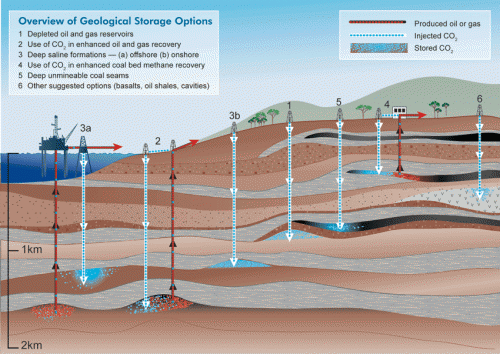According to a new technical market research report, Carbon Capture & Storage Technologies from BCC Research, the global market for carbon capture technologies was worth $88.7 billion in 2007. This is expected to increase to over $236.3 billion by 2012, a compound annual growth rate (CAGR) of 21.8%.
I wonder just how viable carbon capture and storage will be in a world with ever increasing coal/oil/gas prices, and a world in which carbon emissions are quickly devouring the planet. This report also goes against the findings of a similar UN report that show that renewable energy is really where the money is. Assuming however that the entire world isn’t going to suddenly stop burning fossil fuels, carbon capture and storage is going to be an important technology.
So where is all these billions going to come from? The market is broken down into applications of precombustion, combustion and postcombustion. Of these, postcombustion has the largest share of the market. Valued at nearly $51.5 billion in 2007, this segment is expected to be worth $107.0 billion by 2012, a CAGR of 15.7%. Post-combustion, which involves chemical stripping of carbon dioxide (CO2) from various gases by bubbling the gases through liquid chemicals, is the most mature and so far the technology to beat in price and reliability.
The second largest segment, precombustion, was worth an estimated $34.6 billion in 2007 and will reach $124.9 billion by 2012. Precombustion involves gasifying coal to extract a synthetic natural gas that is then burned in an Integrated Gasification Combined Cycle plant, a process that emits much less CO2 than a traditional coal plant and can be configured to be a near zero emission plant with the addition of post-combustion technologies. Demand for clean as well as cheap energy sources such as coal is driving this market, even though the price of coal has been shooting up along side the price of oil and gas.
Combustion is currently a $500 million sector that will be worth $2.0 billion in 2012, for a CAGR of 32%.

By 2025 more than 10 billion metric tons of CO2 will need to be captured each year and CO2 emissions will still continue to grow (if we continue on our current course). A global infrastructure that will ultimately cost more than $15 trillion may need to be installed over the next century to accomplish that ever increasing annual task.
I assume most people will realize the folly of spending 15 trillion dollars on carbon capture, when we could create a world wide infrastructure of wind/solar/biomass/etc energy production, most likely for less. I see carbon capture and storage technology being used mainly for legacy infrastructure.
There are fundamental problems with continuing to increase the rate at which we burn fossil fuels, security, global warming, supply, pollution, etc. Wind, solar, and biomass technologies will provide the bulk of future demand, with a few legacy coal/oil/gas plants. These plants will need to have all of the carbon emissions captures and stored if we are to return the atmosphere to a state in which run-away global heating is not a concern. Lets hope the promise of future capture markets will spur this technology to achieve high efficiency and reliability, I shudder to think what would happen if the stored co2 suddenly escaped en-mass. Carbon capture is going to play an important role in our future, but a minimal one.
